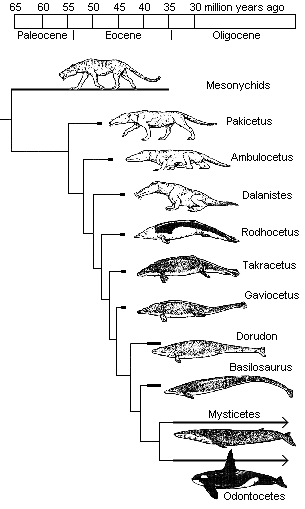Answers in Genesis states this in their article on Pakicetus:
"The ‘whale’ status of Pakicetus received another potentially fatal blow. This came from a recent study of the semicircular canal systems in both living and fossil cetaceans (whales and dolphins).1 The semicircular canal system is a set of tubes connected to the inner ear that provides information on head (and therefore also body) movements. The tubes are filled with small, solid particles suspended in liquid. The inner surfaces of the tubes are covered with sensors that show which way the contents are flowing. This organ gives us our sense of balance.
To the surprise of the international team of scientists, the cetaceans, both living and fossil, all had the same ‘unique’ small canal size—about three times smaller than all other mammals, when corrected for body size.1 The researchers suggested that the canal system had to be small to reduce the sensitivity, thus preventing information overload as the animals rolled around.1 They concluded that the early whales had semicircular canals unlike those of any non-cetacean mammal. This, they said, shows that even the ‘earliest’ whales had unique behaviour, suited to aquatic life.
But while the paper defended whale evolution, the detailed analysis demonstrated a sharp gap in relative sizes between whales and non-whales, including the pakicetid Ichthyolestes (creationists would probably group it into the same created kind as Pakicetus). There were no examples of slow and gradual shrinking of the canals—they were either one relative size or the other.2 In fact, the paper affirms that the alleged change in canal structure happened ‘instantaneously’ and produced a ‘unique’ apparatus."
So the shrinking of the semicircular canals happened "instantaneously"; and it of course follows from this that evolution is wrong. Right? Uh-Uh. You see, the fact that the evolution of the canals happened rapidly while the evolution of the rest of the body happened more slowly is not evidence against evolution. These canals are used for maintaining balance. Movement in the water, and balance in the water, would be very different from movement and balance on land. These canals would be a very important step in evolution, and therefore this adaption would spread much quicker than other adaptions might. The Science Blog Afarensis has a good article on this.
The same type of claims about semicircular canals have been made before, except with Apes and humans instead of whales. The man that AiG references, Fred Spoor, has admitted that "Any link between the characteristic dimensions of the human canals and locomotion will be more complex than a simple association with the broad categories of quadrupedal vs. bipedal behavior." So the inner ears are just not enough to draw any simple conclusions from.
One last thing: AiG claims that Pakicetus is a fully terrestrial mammal, and not aquatic. The Northeastern Ohio Universities College of Medicine has a different story to tell:
"The skulls of pakicetids have an ear region that is highly unusual in shape, and only resembles that of modern and fossil whales. These features are diagnostic for cetaceans, they are found in all cetaceans, and in no other animals. These features are main why pakicetids are considered whales. In many other features, pakicetids are also similar to some whales, but those features are not shared by all whales. An example of the latter is the dentition. Pakiceid teeth look a lot like those of fossil whales, but are unlike those of modern whales. Pakicetids did not live in the sea. The rocks in which their fossils are preserved indicate that the bones were buried in a shallow stream, and that the climate was hot and dry. It is likely that pakicetids waded in these streams. Their bones are unusually thick, possibly an adaptation to make the animal heavier counteracting the buoyancy of the water."
So there are many indications that they are ancestors of whales, and that they were semi aquatic.
It's sad that AiG does absolutely no research to back up their claims. They make blind and bold assertions that simply have no basis in science. This is such a very clear cut case of evolution, too. Pakicetus was found in the early Eocene strata, Ambulocetus was found in the early to middle Eocene, and Rodhocetus was found in the mid to late Eocene. It's very sequential.
For more, see Ed Babinski's article on the evolution of whales.
